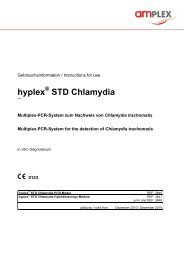hyplex SuperBug ID
hyplex SuperBug ID
hyplex SuperBug ID
You also want an ePaper? Increase the reach of your titles
YUMPU automatically turns print PDFs into web optimized ePapers that Google loves.
11. Evaluation<br />
The test can be evaluated under the following conditions:<br />
Extinction of reagent control ≤ 0.200<br />
Extinction of negative control (NCE) ≤ 0.200<br />
Extinction of positive control ≥ 1.500<br />
When the signal strength of the positive control is low, weakly positive samples may be<br />
unintentionally evaluated as negative. The hybridisation temperature or the temperature<br />
of stringent wash solution may have been too high (see also 14).<br />
Analytical criteria with use of cellular material from a pure culture or from DNA<br />
isolated from it:<br />
<br />
<br />
<br />
Samples with extinction values of greater than 0.400 are treated as positive<br />
Samples with extinction values of between 0.200 and 0.400 are borderline. They<br />
should be retested.<br />
Samples with extinction values of less than 0.200 are treated as negative<br />
Analytical criteria with directly use of patient material or DNA isolated from it:<br />
<br />
<br />
<br />
Samples with extinction values of greater than 0.300 are treated as positive<br />
Samples with extinction values of greater than 3 x NCE and less than 0.300 are<br />
borderline. They should be retested.<br />
Samples with extinction values of less than 3 x NCE or less than 0.150 are treated<br />
as negative<br />
12. Interpretation of the test results<br />
The <strong>hyplex</strong> ® <strong>SuperBug</strong> <strong>ID</strong> system is a rapid, universally applicable screening test for<br />
the detection of genes encoding the most common medically relevant metallo-ßlactamases<br />
VIM, IMP and NDM-1 as well the carbapenemases of the OXA-48- and<br />
KPC-type.<br />
Positive results of the <strong>hyplex</strong> ® <strong>SuperBug</strong> <strong>ID</strong> system demonstrate the presence of<br />
carbapenemases-associated genes in a sample. This does not mean that the genes are<br />
also actually expressed. The pathogens found in the tested sample, however, possess<br />
the potential to express the genes. In addition, no conclusions on, for example, the<br />
minimal inhibiting concentration of certain β-lactam antibiotics, and in special<br />
carbapenems, for the pathogen can be made based on the results of this test system.<br />
The results obtained from the <strong>hyplex</strong> ® <strong>SuperBug</strong> <strong>ID</strong> system are dependent upon the<br />
quantity and quality of the DNA in the sample. Through the <strong>hyplex</strong> ® <strong>SuperBug</strong> <strong>ID</strong> PCR<br />
Module, low copy numbers of relevant DNA (corresponding to 9.3 x 10 3 genome copies<br />
/ ml) are amplified to such an extent that positive signals are observed.<br />
A negative test result from the <strong>hyplex</strong> ® <strong>SuperBug</strong> <strong>ID</strong> system cannot completely<br />
exclude the possibility of the presence of carbapenemases producing bacteria in the<br />
sample material.<br />
31




